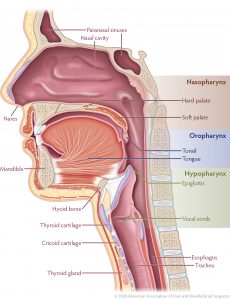Oral, Head and Neck Cancer
More than 53,000 Americans will be diagnosed with oral or oropharyngeal cancer this year, according to the National Cancer Institute. The mortality rate for oral cancer is particularly high – not because it is hard to detect, diagnose or treat, but because the cancer often is discovered late in its development. That’s why routine self-exams and routine dental/medical checkups are so important. And if a suspicious lump, sore or lesion is discovered, be sure to make an appointment with an oral and maxillofacial surgeon who can provide a diagnosis and offer treatment options.

OMS Voices Preview: Oral Cancer and the OMS
Types of Oral, Head and Neck Cancer
There are five major types of head and neck cancer, with oral cancer (including cancers of the lip and inside the mouth) considered a type of head and neck cancer. Each type of cancer is named for the location where it develops:
- Oral and oropharyngeal cancer – Oral cancer occurs in the oral cavity, while oropharyngeal cancer occurs in the oropharynx. The mouth and tongue make up the oral cavity. The oropharynx spans the middle of the throat, from the back of the tongue to the tip of the larynx and includes the tonsils.
- Laryngeal and hypopharyngeal cancer – Laryngeal cancer occurs in the larynx, and hypopharyngeal cancer occurs in the hypopharynx. The larynx is a tube-shaped organ in the neck, commonly referred to as the voice box. The larynx is located at the top of the windpipe and is important for talking, swallowing and breathing. The hypopharynx is the lower part of the throat. It surrounds the larynx and is sometimes referred to as the gullet.
- Nasal cavity and paranasal sinus cancer – Nasal cavity cancer occurs in the nasal cavity while paranasal sinus cancer can occur in one or more of the paranasal sinuses. The nasal cavity is located directly behind the nose and is where air passes from the nose to the throat. Paranasal sinuses are the air-filled areas surrounding the nasal cavity.
- Nasopharyngeal cancer – Nasopharyngeal cancer occurs in the nasopharynx, another air passageway. The nasopharynx is located behind the nose at the upper part of the throat.
- Salivary gland cancer – Salivary gland cancer occurs in the salivary gland, which is responsible for producing saliva. Saliva is the fluid that keeps the mouth moist and contains enzymes that start breaking down food.

OMS Voices Preview: What to Do When You Find a Bump in Your Mouth
Besides those listed above, other types of cancer can be found in the head and neck region. It’s important to remember that not all oral, head and neck pathologies are cancerous.
While certain oral pathologies can be precursors to cancer, a proper diagnosis requires a biopsy of the tissue. During a biopsy, the area is numbed similar to how the gum around a tooth is numbed for a filling. Then a small piece of tissue is removed and sent to an oral pathologist, a specialist who examines the tissue microscopically for evidence of cancer cells.
Oral cancer is classified according to the size of the tumor, the location and the number of draining lymph nodes in the neck. There also can be different types of oral cancer and each one has its own treatment response. Tests will be done to determine the stage of the cancer.
Find an OMS Near You
Everyone should make it a routine to perform monthly cancer self-exams. However, those with risk factors for oral, head and neck cancers should undergo an annual exam by an OMS or dentist. These risk factors include:
- Use of tobacco, including cigarettes, pipes, cigars, snuff, chew or smokeless tobacco.
- Alcohol consumption, particularly when consumed with tobacco products.
- The human papillomavirus (HPV).
Early detection and treatment may well be the key to complete recovery.


